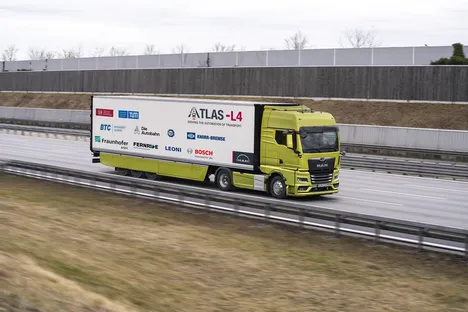ATLAS-L4: Automated transport between logistics centers on highways in level 4
Contact person: Baha Zarrouki, M.Sc., Sven Goblirsch, M.Sc., Tobias Kerbl, M.Sc., Ines Trautmannsheimer, M.Sc.
Project description
Trucks are one of the main carriers for goods. The trend of autonomous trucks offers many advantages for the freight transport sector including faster transport by avoiding mandatory breaks, solving the driver shortage problem, more traffic safety by anticipatory planning and environmental benefits.
At the Chair of Automotive Technology we work with various industry partners and other research institutes on the ATLAS-L4 project. Our main goal is to make truck-trailers drive autonomously hub-to-hub on highways (level 4).
Workpackages in FTM
- Motion Control (Contact: Baha Zarrouki, M.Sc.)
Within the scope of autonomous driving, the truck's longitudinal and lateral motion control to follow the planned trajectory is challenging. To illustrate the control challenges within the ATLAS-L4 Operational Design Domain (ODD), the tractor-trailer system has a limited time window to merge into one highway lane due to the merging lane longitudinal limits and the presence of other road participants. Disturbances and parameter uncertainties such as crosswind, longitudinal- and lateral road banking, and varying trailer load induce strong system state prediction deviations. Hence, the controller can fail to meet the tight time constraints of the reference trajectory, which can lead to safety-critical situations. Thus, we want to achieve a robust control performance.
- Tire-Road Friction Estimation (Contact: Sven Goblirsch, M.Sc.)
Knowledge about the maximum transferable force between tire and road is key to safely operate an autonomous vehicle. The vehicle specific dynamic limits must never be exceeded even under highly challenging conditions, e.g. low friction scenarios or emergency trajectories such as maximum deceleration or evasive maneuvers. Doing so would lead to a loss of control over the vehicle. To estimate the limit of the tire-road friction potential cause- and effect-based methods are applied, compared and in a further step combined to decrease the uncertainty of the prediction and thereby increase the robustness of the estimation.
-
Remote-Assistance on Perception-Level (Contact: Tobias Kerbl, M.Sc.)
Autonomous vehicles (AVs) are confronted with a multitude of challenges in the form of unusual and unforeseeable scenarios, known as edge cases, which can include changing weather conditions, unconventional road layouts, and unanticipated obstacles. Due to the vast number of potential edge cases and their inherent complexity, it is unlikely that all of them can be accounted for during the development of AVs. As a result, it is inevitable that AVs will encounter edge cases during their operation on public roads. To address edge cases during the operation of AVs, teleoperation can provide a fallback solution by enabling a human operator to remotely control (remote-driving) or assist (remote-assistance) the AV. One viable approach for remote-assistance of AVs is to interaction with its perception and interpretation of the surrounding environment. The operator can provide support to the AV by classifying objects, disregarding false-positive detections, or adjusting the predicted behavior of other road users. Given the additional information from the operator, the AV is enabled to continue its mission autonomously. -
Latency and image quality (Contact: Ines Trautmannsheimer, M. Sc.)
Teleoperation is a fundamental element in the development of AVs, as it allows an operator to intervene in an emergency to resolve situations that the vehicle cannot handle. To do this, camera and sensor data is transmitted from the vehicle to the operator via mobile radio, and control signals are sent to the vehicle. However, a poor mobile phone connection can affect image quality and cause delays in data transmission. This affects the operator's ability to safely steer the vehicle and, for example, detect obstacles or stay in lane. User studies will be carried out as part of the project to determine the severity of the impairment caused by poor image quality and latency. These will initially analyse the influence of image quality and latency separately, in order to examine both in relation to each other in a main study and thus identify metrics for evaluating the safety of the present use case.
